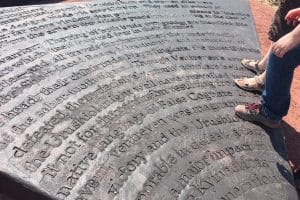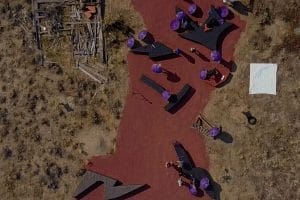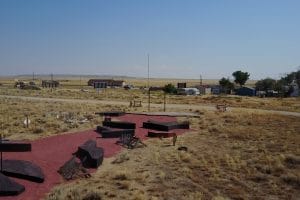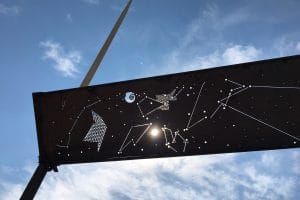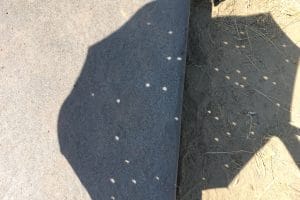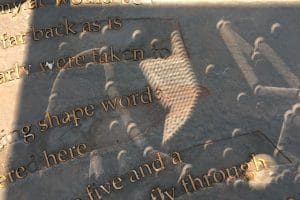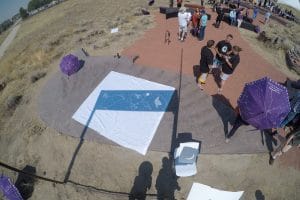Overview
Access
Eclipse (and Dedication)
What it says here . . .
More than One Moon in the Sky; Astronomers of Sem/eh..; some words on this land
The part of the story installed here:
More than One Moon in the Sky

Astronomically, we think of this spot today as a point on the path of a total Solar eclipse, but this was also a place of other eclipses of other kinds, of sabertooths and war rattles, where creatures at times rained gently down from the sky, and where two traditions of astronomical exploration co-existed. There were the xthaedransg, who, as creatures without metabolism, were perfectly suited for space travel—none more famous than Fafamyjac. And then the Saqhaelin people with their exquisite vision, observing the—for others—invisible with a curiosity and grace embodied by the great seer, /œ/ (pronounced zhezh).
Astronomers of Sem/eh@vren

A generation of generations ago, in the parallel universe known as Kcymaerxthaere, the shapes you see here would have represented just one small part of an vast landscape of forms stretching out in every direction, even a bit past what we call the Wind River. This arrangement served as both astronomical archive and cosmological observatory and it was known as Sem eh vren—A Journal of Heavens
Key to the astronomical community stewarding this archipelago of records were people of Saqhaelin descent—famous for vision so sharp they had to close their eyes to see as badly as we do. Indeed, with the naked eye, the Saqhaelin could easily see all the moons of Jupiter—and used those moons to keep time. Familiarity with the inner moons—with their faster orbits— was considered critical to any Saqhaelin kitchen.
In fact, the moon we call Adrastea is particularly favored by chefs: not only is the time Adrastea takes to complete a transit of Jupiter just right for roasting a medium-size game bird like a Hemit [≈14 pound, at low temperature], it also crosses the Great Red Spot at a pace perfect for baking a tray of the local dessert, ek arve [pronounced zhek zharve]—kind of like a streckle-nut brownie. On the other hand, the so-called Galilean moons are best for scheduling at the time scale of one of our weeks.
The astronomers were important to other area cultures as well. Uruss Kush (we call it Themisto), a Jovian moon with an orbit of almost 130 linear Earth days, was a reliable benchmark for the nomadic warriors known as the Urushiol. Once per orbit, as required for their cultural ceremonies, they would gather at a different hot springs in their territories. As a result, the Urushiol were quite protective of Sem eh vren— good fortune for those tending it. Even Nobunaga-Gaisen, when sending Minotsuna Tano’s elite forces through the Umbrasphaere to encircle the Urushiol at the Battle of the Platte, was careful to respect the astronomers’ neutral status.
The Urushiol were tough, sometimes brutal, people. Urushiol men and women alike were famous for the elaborate tattoo—like designs made via scarrification. They used an extract of gallaatan, a poisonous plant far, far more virulent than poison oak (its name means to “inscribe with fire”). That intensity offers the artisan remarkable precision of drawing at the cost of searing pain to the warrior. The ring of both bride and groom are inscribed this same way—a fact which itself inspired fear in their enemies.
In battle—and all travels for that matter, they rode Woolly Mammoths, Short-faced Bears, Miracinonyx, and, naturally, at the head, their chiefs rode Nayn Jingkats, the most literate of the saber-tooth tigers. Though Ventreven’s armies defeated them decisively, many scholars believe the Urushiol might well have prevailed were it not for the confusion resulting from their native language of False Cognate. In any event, Ventreven was magnanimous in victory and the Urushiol were honorable in defeat, a fact with a major impact for all the Kymaericas many generations later.
Some Words on This Land

Kcymaerxthaereal times were and are quite different than ours (though they do intersect in certain ways—including places like this), with different creatures and cultures than ours and even different understandings and even laws of physics. There are also different languages. One in particular is called Nyelvate and it was first developed by people who are biologically aquatic. Because it is difficult to vocalize underwater, these folks learned to psycheform (create shapes with their minds). These shapes could have over a dozen or so different dimensions, so over time a pidgin Nyelvate developed in just 2 or 3 dimensions. Here follows a modest dictionary of what we have here:
![]() = Jemvela. Qualities of existence like Time, Space or Ferylemt, which is as different from Time and Space as they are from each other.
= Jemvela. Qualities of existence like Time, Space or Ferylemt, which is as different from Time and Space as they are from each other.
![]() = A luminous textures of textures as it only appears on the lunar surface.
= A luminous textures of textures as it only appears on the lunar surface.
![]() = Smallest of the 4 inner moons of the planet ___. Second one out. We call it Adrastea
= Smallest of the 4 inner moons of the planet ___. Second one out. We call it Adrastea
![]() = Vela/. The place where the dreams of imaginary creatures come to life.
= Vela/. The place where the dreams of imaginary creatures come to life.
![]() = Reflection
= Reflection
![]() = Commitment
= Commitment
![]() = Eclipse
= Eclipse
![]() = Orbits
= Orbits
![]() = Rœv
= Rœv![]() mer
mer![]() c. A secret or confidence, easily and delightfully shared, but not necessarily with all. (
c. A secret or confidence, easily and delightfully shared, but not necessarily with all. (![]()
![]() are pronounced as an intake of breath and together indicate the second half of the words is pronounced while inhaling.)
are pronounced as an intake of breath and together indicate the second half of the words is pronounced while inhaling.)
![]() = Dayelix. A grouping of universes in the xthaere. Can also be a grouping of xthaeres in the universe.
= Dayelix. A grouping of universes in the xthaere. Can also be a grouping of xthaeres in the universe.
AntHill (leaveblank) Fifth planet from our Sun. We call it Jupiter.
The purest, happiest moment
Xthaedra, a creature without metabolism or volume, only edges, angles and sometimes sides, and always with a gift of conversation.
Tenderness
Vinggscape Detail, Gateway to the Dayelix; Hoketay; Rotu
Vinggscape Detail, Gateway to the Dayelix

For xthaedransg, having no metabolism and only edges and angles has great benefits—they pass through stone as easily fish through water, living in the Earth itself. Indeed, when they travel through air, they must be in contact with a small stone—they don’t really “hold” it as much as persuade it by dimension to travel with them. Post lunar space travel also suited them well, and Fafamyjac would be one of the pioneers. As far back as is known, xthaedra regularly were taken to the moon by inhabiting shape words like the ones scattered here.
Yaarayehyay, the five and a half-winged birds that can fly through time and ferylemt, also collect Nyelvate shape words like the ones to build their nests and also to fulfill their vision by completing a puzzle on the Moon. A community of impish xthaedra there are constantly undoing the puzzle. And yet, the rather long life (by human standards) of a xthaedra is not care-free, because every generation lives in the shadow of near total sacrifice that must some day come in order for the community to continue.
As the great Astronomer /oe/ (pronounced zhezh) made many of the observations that covered this landscape, the xthaedra Fafamyjac watched him from underground and began to understand his work.
Hoketay

Soon the xthaedra Fafamyjac was above ground—holding a small stone, of course—and, by using the xthaedral edges and angles to make Nyelvate words, conversing with /œ/ [pronounced ZHEHZH]. The two astronomers began a journey of exploration, where, cautiously at first, Fafamyjac used the gateway to the Umbrasphaere to enter the darkness of Space. It turned out the speed of darkness was even greater than the speed of light—especially when you were a creature made only of edges and angles. Soon Fafamyjac learned to let go of the stone briefly and travel further—to asteroids and any of Jupiter’s moons. Results all recorded in Sem/ehகுvren [pronounced sem-zhe-URV-renn]: A Journal of Heavens.
Next the duo discovered the rotu—the eclipse within an eclipse. They realized that if one traveled to a point in Space where the Moon blocked the Sun while other moons or objects blocked other stars, then that shadow was the tiniest bit darker and Fafamyjac could go a bit further. Relentlessly, discovery built on discovery, crossing dimensions and leading to the stuff of legend: the trip to the Nebula Bepela.
The story of this place would not be complete without the story of their most popular triumph: Hoketay, also known as shadow surfing, and named after a dimension that /œ/ and Fafamyjac discovered. In this dimension, a shadow has a very small force, a bit like gravitation, that can suspend in space a tiny mass—for example, that of a xthaedra holding a grain of sand. And, harnessed properly, this allows a xthaedra to travel through space with—and at the speed of—the shadow of the Moon.
And the greatest Hoketay of them all happened here. Knowing an eclipse was coming, they calculated that, during totality, all the moons of Jupiters would be eclipsing distant stars, making this a very powerful rotu indeed. Fafamyjac gathered 841 xthaedransg and, for an exhilarating year, they sped through Space, the solar wind in their segments, crooks and perimeters.
Eventually, shadow touched what we call the Earth, in much the same place as the 2017 eclipse, racing towards this spot. At just the right moment all the xthaedransg released their grains of sand, which burning on re-entry, delivered a meteor shower amidst the glorious darkness of eclipse. /œ/ closed his eyes to see its majesty and opened them to see its perfection.
Rotu

Each of these forms—and the thousands of others we cannot see beyond the confines of this site—was a record of important astronomical events, such as eclipses, transits, vinggvagn, aigheenla, rotu—and others. And on these forms the xthaedransg, even Fafamyjac, awaited them with great enthusiasm —especially rotu, the rare and legendary eclipse within an eclipse.
Gateway to the Umbrasphaere; A Host of Roev...; Dark Prophecy
Gateway to the Umbrasphaere
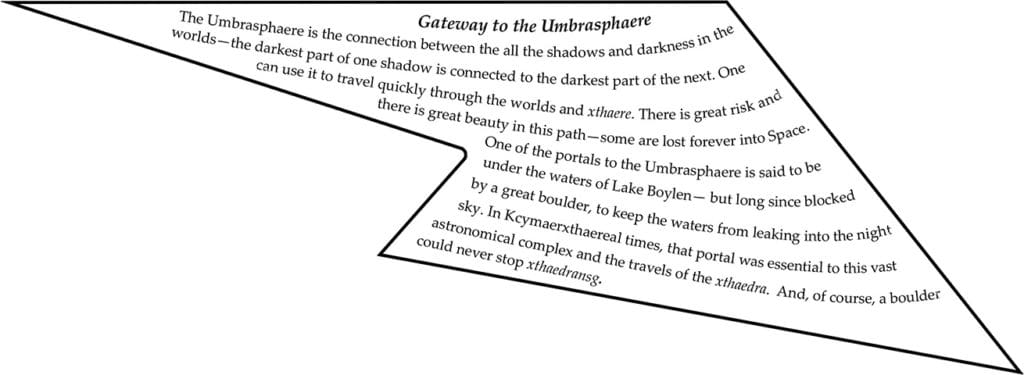
The Umbrasphaere is the connection between the all the shadows and darkness in the worlds—the darkest part of one shadow is connected to the darkest part of the next. One can use it to travel quickly through the worlds and xthaere. There is great risk and there is great beauty in this path—some are lost forever into Space. One of the portals to the Umbrasphaere is said to be under the waters of Lake Boylen— but long since blocked by a great boulder, to keep the waters from leaking into the night sky. In Kcymaerxthaereal times, that portal was essential to this vast astronomical complex and the travels of the xthaedra. And, of course, a boulder could never stop xthaedransg.
A Host of RœvΩmerΩc

Around this site and on this form, a Nyelvate word meaning rœvΩmerΩc (a secret intended to be happily shared, but not necessarily to all), are the initials of some of those who witnessed the 2017 eclipse from this site and this town–and other friends and family connected to these places.
Dark Prophecy

The mass-less xthaedransg fluttered down, and Fafamyjac landed here, at one with the shadows. These joys were parting gifts of Fafamyjac and /œ/ to each other for their unexpected friendship, because a dark (and not the beautiful dark) prophecy was calling all the xthaedransg to action. And the two friends would be unlikely to fathom another moon together for a very long time—if ever again at all.
Bench of Totality and other eclipse experiences

Two More Forms
Qualities of Existence

In our linear world, there are 69 known moons of Jupiter (as of the 2017 eclipse), but in the parallel world there are at least twice again as many—most of which don’t even exist in Time or Space. Time and Space are the two jemvela (a cognate word meaning “a quality of existence”) we know best from our linear world, but in Kcymaerxthaere there are more. Indeed, /œ/ and Fafamyjac, amongst the most skilled and experienced astronomers ever to practice here at Sem/ehகுvren, could well perceive a few dimensions of some jemvelac. Many moons travel through the quality of existence called ferylemt—sometimes erroneously thought of as the structure of Time because of the trails it leaves behind. But it was /oe/ who proved such traces are completely disconnected from the expressions of other jemvela ( ferylemt trails are why ghelyrns, massive dirigibles filled with water, are able to float up out of the ocean and float across continents). And Fafamyjac has danced on the moons that orbit through Lyhaedr, the realm of “the equivalent of light”. And there are quite a few more jemvela which may yet yield their moons. As the Saqhaelin proverb goes: “Not all moons are round—or even found.”
Gallery
Related Stories
Some well known characters of the xthaere
- Nayumbo's Wall
- Nature of the Waters
- Pracownia (Studio) Forresta Bessa
- Forest's Rest
- Cosmologies Intimes (Intimate Cosmologies)
- Three Rezhns, One Name
- More Than One Moon in the Sky
- Faith of the [Valp]
